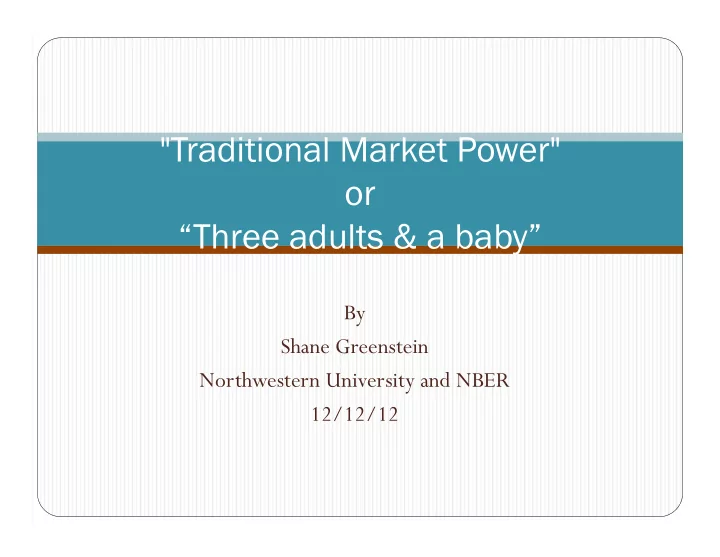

"Traditional Market Power" or “Three adults & a baby” By Shane Greenstein Northwestern University and NBER 12/12/12
Thanks Thanks for the opportunity to talk. The email asked for volunteers. I was going to present a standard textbook presentation of measuring monopoly. In my role at NBER I have been thinking about “digital dark matter” – economic activity in the digital economy that standard GDP measurement fails to capture. Could not help but see (or not see) some digital dark matter here… Try to frame a few questions…
What does this talk do? Do traditional economic measurement of monopoly offer guidance to measurement for communications policy? Under premise that the country will experience concentrated access supply, and will face a range of policy issues related to that. Definition of traditional: it has shown up in a respectable economic textbook for at least half a century. Three adults: textbook GDP measurement; a regulatory adult; an antitrust adult. The baby: multi-sided platforms. My first big point: We tend to conflate the three adults, but should not. My second big point: There is more digital dark matter than one might have thought. My third big point: it is not clear our standard approaches are useful in this context.
Standard textbook GDP measurement: Cannot get “price”... Measure price? CPI for Internet access Why? W/revenue, it gives us Q. Gross margin. How to interpret 2007 73.2 when fixed costs are large ? 2008 73.9 We do that already in the CPI. Is 2009 76.5 it informative? Actually, we do 2010 77.0 not do this well… 2011 76.3 Price & user satisfaction differ. Despite widely measured gain in access quality – Measure WTP ( Rosston, Savage SamKnows & Ookla both & Waldman) for NBP . Different show it – CPI shows little from GDP . price decline, and does not incorporate gain from Do not yet measure contribution qualitative improvement. of Internet to economy.
Does treatment of monopoly in antitrust offer guidance? Well… No presumption of monopoly unless proven in hearings. Legal proceedings: Burden of proof lies w/prosecutor (sort of). Market def’n in court. Broad/narrow favors firm/prosecutor. SSNIP: small significant non-transitory increase in price. Market def’n for administrative review, such as FTC/DOJ under merger guidelines. FCC review when it has jurisdiction (e.g., AT&T-TM). Market share alone not sufficient… It is very expensive to do: moving target behind measurement. Measuring substitution b/w wireline/wireless data use. Substitutions for which users deploying which services in which locations? Habit in antitrust not great for many policy questions… Uninformative about innovation, about operations of the network, for many key questions…
Does regulatory monopoly offer useful example? Well… Presumption of monopoly or lack of close substitutes. Burden of proof lies w/firm to show no monopoly power (e.g., telephone firm and in adjacent markets). BTW , usually a foundation in law, which is problematic here… Two regulatory instruments – price and profits limits – have challenging measurement components. Accounting tricks to manipulate price indices & profit levels… If we do not measure prices well, do we really want to go back to this? Non-price measurement: Tendency to police “discriminatory behavior” by using bright lines (e.g., Computer II). Habit in antitrust not great for many policy questions… Uninformative about innovation, about operations of the network, for many key questions…
Two instructive examples for illustrating role of measurement AT&T lost T-Mobile a textbook horizontal merger. No way around fact that supply was already concentrated. Especially in local geographies… Merger would concentrate it further & efficiency gains modest. The lawyers knew it. It’s in guidelines. Judges everywhere accept this… Comcast was able to merge with NBC… Vertical merger with potential for concentrated distribution. Market def’n framed merger around a classic debate…Can a monopolist in distribution merge with supplier of content? Yes, (simplifying) after they adopt a consent decree – namely, Comcast promises to treat own and outside content in non-discriminatory way. If wireless/wireline becomes substitutes, this won’t be necessary…
The baby, multisided platform (and growing fast) Used to be just newspapers, weeklies, etc. Then it applied to O-systems, Walled Gardens, Open source… Internet access at risk to be bundled with other services. If AOL-TW merger had succeeded, would be wrestling w/this now… Horizon: Comcast, Google, Apple, Facebook moving in this direction…. Some commonalities across most platforms Reduce search or transaction costs, help others build. Shares resources across user base. Usually a network effect. Also common: One side pays & the other is free. Feels like a monopoly to paying side. Just ask advertisers who have no choice but to bid on Google, or sites using SEO to appear high on search. Measurement? Sure. A great dissertation topic.
Summary Long history of economic measurement in concentrated industries in communications, and some lessons for access. I would not call the history inspiring. Measurement tends to work best when married to good judgment & efficient review processes and absence of ad hoc policy making. We are not doing a good job measuring this stuff for GDP , so I am not sure we will do any better with traditional approaches to measuring monopoly in a regulatory setting. And watch out for the teenager. Will be a grown up soon.
Thanks Thanks for listening.
Recommend
More recommend